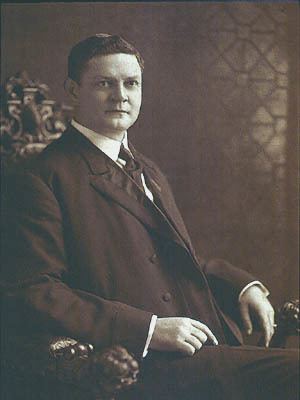Preceded by Lewis L. Morgan Preceded by Newton C. Blanchard Political party Democratic Education Tulane University Succeeded by George K. Favrot | Lieutenant Paul M. Lambremont Preceded by Newton C. Blanchard Name Jared Sanders, Party Democratic Party Children Jared Y. Sanders, Jr. | |
 | ||
Born January 29, 1869
Inglewood Plantation, east of Morgan City, Louisiana ( 1869-01-29 ) Resting place Franklin Cemetery in Franklin, Louisiana Role Former Governor of Louisiana Died March 23, 1944, Baton Rouge, Louisiana, United States Previous office Governor of Louisiana (1908–1912) | ||
Jared Young Sanders, Sr. (January 29, 1869 – March 23, 1944), was a journalist and attorney from Franklin, the seat of St. Mary Parish in south Louisiana, who served as his state's House Speaker (1900–1904), lieutenant governor (1904–1908), the 34th Governor (1908–1912), and U.S. representative (1917–1921). Near the end of his political career he was a part of the anti-Long faction within the Louisiana Democratic Party. Huey Pierce Long, Jr., in fact had once grappled with Sanders in the lobby of the Roosevelt Hotel in New Orleans.
Contents
Early years, education, family
He was actually Jared Jordan Sanders, born on Inglewood Plantation near Morgan City, also in St. Mary Parish, to Jared Young Sanders, II, and the former Elizabeth Wofford. He did not use the Roman numeral "III" but was referred to as Jared "Sr.", after the birth of his only son, "Jared Young Sanders, Jr.," but really Jared Sanders, IV. Sanders was educated in the public schools of Franklin, St. Charles College in Grand Coteau, and the Tulane University Law School in New Orleans, from which he received his LL.B. degree in 1893. He was the editor and publisher of the weekly Franklin newspaper, the St. Mary Banner, from 1890 to 1893. He launched his law practice in New Orleans in 1893, and his firm included a cousin, former Governor Murphy J. Foster, Sr., grandfather of future Republican Governor Murphy J. "Mike" Foster, Jr. (1996–2004).
On May 31, 1891, Sanders married the former Ada Veronica Shaw of Fouke in Miller County in H. Shaw. Their son, Jared, Jr. (actually Jared, IV), would also become a U.S. representative. The couple divorced after Sanders' term as governor ended in 1912. Sanders then married the former Emma Dickinson of New Orleans.
Legislature to governorship
Sanders served in the Louisiana House of Representatives from St. Mary Parish for two nonconsecutive terms, 1892–1896 and 1898–1904. He was strongly anti-lottery. He was also a delegate to two Louisiana constitutional conventions, 1898 and 1921. After his speakership, he was lieutenant governor, an official when then (but no longer) presided over the state Senate. He is one of the few Louisiana politicians to have been elected governor while serving as lieutenant governor, the most recent to have done so being Governor Kathleen Babineaux Blanco, elected in 2003. Sanders was the first Louisiana governor elected by primary balloting.
In the 1908 general election Democratic nominee Sanders polled 60,066 votes (87.1 percent) to Republican Henry N. Pharr's 7,617 ballots (11.1 percent). Governor Sanders was remembered as the "father of the Good Roads Movement in Louisiana."
In 1908, newly inaugurated Governor Sanders named lumber magnate Henry E. Hardtner of Urania in La Salle Parish to head the new seven-member Conservation Commission on Natural Resources, which began work on reforestation and the prevention of forest fires. Hardtner had not been a Sanders supporter in the previous campaign and made special effort to please his benefactor, having launched one of the most ambitious conservation agenda in the nation. Sanders named another of his 1908 supporters, Connell Fort, later the mayor of Minden, as the conservative agent for northwestern Louisiana.
On July 5, 1910, the Louisiana legislature named Sanders to finish the U.S. Senate term of Samuel D. McEnery, but he declined the position in order to finish his term as governor. He tried in vain to have New Orleans designated as the site for the World Panama Exposition.
Sanders and Senate candidate
From 1912–1914, Sanders resumed his law practice. He was also the naval officer of the Port of New Orleans from 1914–1916, at which time he relocated to Bogalusa, the seat of Washington Parish. He was elected to the United States House of Representatives in 1916 from District 6 (Baton Rouge and the Florida Parishes) and served two terms. He did not seek a third term in the U.S. House in 1920 because he ran unsuccessfully for the Democratic U.S. Senate nomination that year. In the Senate primary, Sanders, with 43,425 votes (40 percent) lost to Edwin S. Broussard, who received 49,718 ballots (45.7 percent). A third candidate, Donelson Caffery, drew 15,565 votes (14.3 percent). He was a son of former Senator Donelson Caffery, who like Sanders was a native of St. Mary Parish. There was not yet a runoff in Louisiana primaries, and Broussard was there nominated and elected in the primary.
Sanders was thereafter a delegate to the 1924 Democratic National Convention, in which the attorney John W. Davis of West Virginia was nominated for president on the 103rd ballot. Davis in turn lost the general election to Republican President Calvin Coolidge of Massachusetts. Sanders was again an unsuccessful but serious candidate for the U.S. Senate nomination in 1926. He polled 80,562 votes (48.9 percent) to 84,041 ballots (51.1 percent) for the incumbent Broussard. Broussard served two full terms in the Senate before he was unseated in the primary in 1932 by John Holmes Overton.
Sanders ended his active political career as an opponent of the Huey Pierce Long, Jr., political machine. Sanders was Presbyterian. He died in Baton Rouge and is interred in Franklin Cemetery in Franklin.
